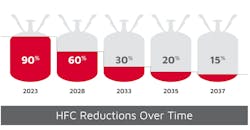On July 1, U.S. Customs and Border Protection seized a shipment of 67 giant African snails, also known as land snails, at Los Angeles International Airport (LAX). Though considered a gastronomical delight by some, the snails are not your ordinary escargot. They grow up to 8 in. in length by 4 in. wide and have an eight- to 10-year life span—less if they are fried and served as a snack, of course. The snails seized at LAX were packed in two picnic baskets and weighed more than 35 lb. They arrived on a flight from Lagos, Nigeria, and reportedly were destined for the city of San Dimas, Calif., 25 miles east of Los Angeles. The snails are dangerous in that they can carry a parasite that can cause meningitis in humans. Here in Florida—especially South Florida, where I live, work, and play—they are just one of many invasive species with which we have to deal. Florida is, according to Doria Gordon, director of conservation science for the Florida chapter of the Nature Conservancy, “ground zero for the impacts of invasive species.” Not surprising, considering our weather.
So, you might ask, what does that have to do with the HVAC industry? As professionals in a construction-related field, we have to be concerned about potential structural damage, as land snails, when they don’t get enough of the fruits and vegetables that constitute their normal diet, will eat a structure’s plaster and stucco to replenish their large calcium shells!
There are other invasive species that impact our industry. Those living in the Great Lakes region have to contend with zebra mussels, which can block cooling-water inlet pipes for power plants and factories. And there are the insects—borers and beetles, for example—that destroy trees, which reduce air-conditioning loads through natural cooling (via shading and evapotranspiration). Trees long have been recognized as an effective heat-island mitigation strategy, and they can reduce heat loss during winter by reducing wind speed across walls and roofs.
Although Florida is particularly vulnerable to biological invasion (25 percent of our wildlife is exotic, more than anywhere else in the United States), this truly is a national problem. Today, according to the experts, there are more than 50,000 alien species in the United States, and some believe them to be the second most significant factor—topped only by habitat loss—in endangering animals. Invasive plants and animals often win by simply out-eating other plants and animals. In 2012, the federal government spent $2.2 billion in the war against invasive species, and yet as global trade increases, so does the problem.
And what about climate change forcing species to move to adapt to rising temperatures? As HVAC professionals, doesn’t that put it at least partly back in our court?











